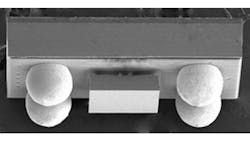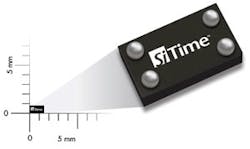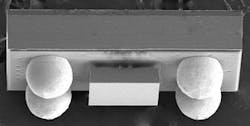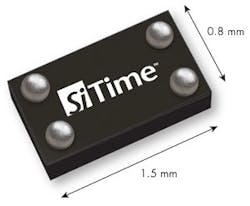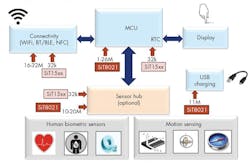This file type includes high resolution graphics and schematics when applicable.
Many emerging electronic applications, including wearable electronic circuitry on clothing, must maintain low-power operation. But achieving such operation requires low-power components, including clock oscillators for timing and frequency control.
Fortunately, SiTime Corp., a firm known for its work in microelectromechanical-systems (MEMS) technology, applied its MEMS prowess to the development of an extremely small, low-power oscillator capable of frequencies from 1 to 26 MHz. The model SiT8021 oscillator (Fig. 1) is a fraction of the size of crystal oscillators and resonators in this frequency range and consumes a fraction of the power, making it ideal for wearable electronics, mobile products, and devices for Internet of Things (IoT) applications.
The MEMS-based SiT8021 is the first member of the firm’s μPower family of low-power, miniature, megahertz-frequency oscillators for wearable, IoT, and mobile electronic product applications. It’s particularly well-suited for battery-powered products in which small size and low-power operation is critical. When used in place of quartz-based crystal oscillators and resonators, the SiT8021 reduces size by about 40% and power consumption by around 90%. It employs a 524-kHz MEMS resonator (based on TempFlat MEMS technology) and a highly optimized phased-lock loop (PLL) to reach high performance levels at megahertz frequencies.
By incorporating MEMS technology, the SiT8021 oscillator is much smaller than its traditional quartz-crystal counterparts. With quartz-crystal oscillators, physics dictates that lower-frequency resonators have larger crystal resonators than higher-frequency resonators. However, MEMS-based resonators do not follow those same guidelines. The typical die size of SiTime’s MEMS resonators is 0.4 × 0.4 mm and its mass is 1/3000th that of a typical quartz-crystal resonator.
Because SiTime’s MEMS-based resonators are fully encapsulated in silicon and manufactured in silicon CMOS fabrication facilities, they can be packaged with modern integrated-circuit (IC) packaging techniques, including wafer-level chip-scale packaging (WLCSP). As a result, the SiT8021 oscillator comes in a chip-scale package (CSP) measuring just 1.5 × 0.8 mm—the industry’s smallest oscillator package (Fig. 2).
As with the firm’s earlier model SiT1552 MEMS-based temperature-compensated crystal oscillator (TCXO), which delivers stable signals at 32.768 kHz with less than 1 {LC MU}A current consumption for supply voltages of +1.50 to +3.63 V dc (see “MEMS TCXO Runs on Micro Current” ), the new SiT8021 oscillator provides stable, low-power signals at somewhat higher frequencies. Since it is composed of all-silicon dies mounted together (Fig. 3), it can be integrated into a compact system-in-package (SIP) module.
The SiT8021 oscillator weighs only 1.28 mg, which is about 70% lighter than the lightest quartz-based oscillator, making the SiT8021 a strong candidate for wearable electronic applications. In fact, the SiT1552 and SiT8021 support a wide range of applications for wearable and IoT products (Fig. 4).
The SiT8021 oscillator’s frequency stability of 100 ppm for frequencies from 1 to 26 MHz in turn provides low-voltage complementary metal-oxide-semiconductor (LVCMOS) outputs. It’s designed for use at +1.8 V dc ±10% and can handle an operating temperature range of –40 to +85ºC. The device draws about 100 µA current in operation, or about 90% less current than a megahertz-frequency quartz-crystal oscillator.
With its wide frequency range, the SiT8021 can even supply output frequencies of less than 5 MHz in plastic CSP housings, not typically available from quartz-crystal oscillators. In addition, the oscillator provides suitable programmable drive levels for multiple loads. As a result, one clock source can be used in place of several, thus saving on a design’s bill of materials (BOM) and in-circuit board space.
In an evaluation for a low-power audio digital-to-analog-converter (DAC) application, a SiT8021 oscillator operating at 3.072 MHz was compared with a traditional quartz-crystal oscillators—and it educed some of the former’s advantages. For example, the SiT8021 MEMS-based source alone consumes about 100-{LC MU}A current and total power consumption was 30 mW. This translates into an effective battery life of 202 hours for the system when using the SiT8021.
A quartz-crystal oscillator, on the other hand, operating at the same 3.072-MHz frequency draws about 2.5-mA current, with power consumption of 34 mW for the same lineup of DAC, oscillator, and amplifier. Such consumption translates into an effective battery life of 177 hours. The comparison assumes a 2000-mAh lithium-ion battery typically used in portable devices. Of course, this is just one application example for a battery-powered audio product, but it offers a glimpse into the gains and advantages that lie ahead for designers working with these low-power MEMS-based frequency sources.
SiTime, a fabless analog IC company, has been a creative supplier of MEMS-based silicon timing solutions since about 2005 (for more on the company, see the “Inside Track” interview with Aaron Partridge, Founder and Chief Scientist of SiTime). Since 2007, the firm has developed and used a 5-MHz MEMS resonator in its oscillator products, and since 2011, a 48-MHz resonator in its oscillator products that offer less than 1-ps jitter.
The company’s MEMS-based oscillators, all of which come with a lifetime warranty, offer high shock and vibration resistance and extremely high reliability for a wide range of low-power applications, notably for battery-powered applications. With the growth of wearable electronics and IoT applications (such as wireless IP cameras designed to operate at extremely low current levels), there’s little doubt the demand for the low power, tight stability, and small size offered by MEMS-based oscillators will continue to grow louder in the coming years.
This file type includes high resolution graphics and schematics when applicable.
SiTime Corp., 990 Almanor Ave., Sunnyvale, CA 94085; (408) 328-4400, FAX: (408) 328-4439, www.sitime.com.
About the Author
Jack Browne
Technical Contributor
Jack Browne, Technical Contributor, has worked in technical publishing for over 30 years. He managed the content and production of three technical journals while at the American Institute of Physics, including Medical Physics and the Journal of Vacuum Science & Technology. He has been a Publisher and Editor for Penton Media, started the firm’s Wireless Symposium & Exhibition trade show in 1993, and currently serves as Technical Contributor for that company's Microwaves & RF magazine. Browne, who holds a BS in Mathematics from City College of New York and BA degrees in English and Philosophy from Fordham University, is a member of the IEEE.
